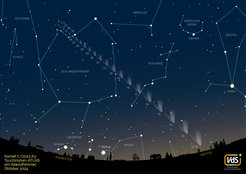Comet C/2023 A3 (Tsuchinshan-ATLAS) in the evening sky
Starting 11 October 2024, comet C/2023 A3 (Tsuchinshan-ATLAS) can be seen with the naked eye at dusk on the western horizon. In the following days, the comet rises higher in the sky, but also becomes fainter. On 19 October, astronomical institutions from German-speaking countries invite the public to observe the comet on Astronomy Day, including MPIA and the Haus der Astronomie.
Comet C/2023 A3 (Tsuchinshan-ATLAS) was discovered on 9 January 2023 as a faint object at a distance of around 8 Astronomical Units at the Purple Mountain Observatory in China. One Astronomical Unit (abbreviated to 1 AU) corresponds to the average distance between the Earth and the Sun and is equivalent to approximately 150 million kilometers. On 22 February 2023, the Asteroid Terrestrial-impact Last Alert System (ATLAS) in South Africa was able to prove that it was not an asteroid, as initially assumed, but a comet. The name of the comet is therefore made up of the of the alternative name Zijinshan Astronomical Observatory for the Purple Mountain Observatory and the abbreviation ATLAS.

Due to its great distance, the comet could initially only be observed by professional observatories and experienced amateur astronomers. Optical instruments were needed at any time to observe the comet approaching the Sun. During this time, however, Tsuchinshan-ATLAS developed its characteristic comet tail. On 27 September 2024, it reached the closest point of its orbit to the Sun at a distance of just 0.39 AU (58 million kilometers), the so-called perihelion. In the days that followed, the comet was in the morning sky right above the eastern horizon immediately before sunrise, but its position relative to the Sun was unfavorable for the German-speaking countries, so that it was not visible in the haze near the horizon. Observers from the southern hemisphere, in the Mediterranean or on the Canary Islands had an advantage here.
As seen from Earth, Tsuchinshan-ATLAS is geting closer to the Sun in the sky in the first few days of October. From 7 to 11 October, it will be seen passing through the field of view of the LASCO C3 camera of the Solar & Heliospheric Observatory satellite SOHO. From 9 October onwards, the comet's angular distance to the Sun will increase again and starting 11 October, it may be possible to see it with the naked eye after sunset in the evening sky right above the western horizon. The best visibility is expected to be on 12 or 13 October when the comet is closest to Earth at a distance of 0.47 AU (71 million kilometers) am nächsten steht. It rises higher and higher each day and thus sets later, but at the same time becomes fainter again as it moves away from the Sun and the Earth.

In order to find Tsuchinshan-ATLAS at dusk, Venus bright above the southwestern horizon, and Arcturus, the brightest star in the constellation of Bootes which becomes visible as one of te first stars in the twilight, can help: The comet is at first below and later above the center of a line connecting Arcturus and Venus.
In the second half of October, the comet is still over 20° high in the sky in the constellation Ophiuchus, even at the end of astronomical twilight. On Saturday, 19 October 2024, observatories, astronomy associations, planetariums, research institutes, museums, schools and individuals interested in astronomy from all over Germany invite the public to observe the comet as part of the nationwide Astronomy Day. Haus der Astronomie and the Max Planck Institute for Astronomy are additionally offering a family event and a public talk on comets (in German), and will broadcast the livestream of the Lange Nacht der Astronomie, which is taking place on the same day. At the end of October, the brightness of Tsuchinshan-ATLAS will decrease rapidly, but until mid-November it can be easily observed in the evening sky with binoculars.

